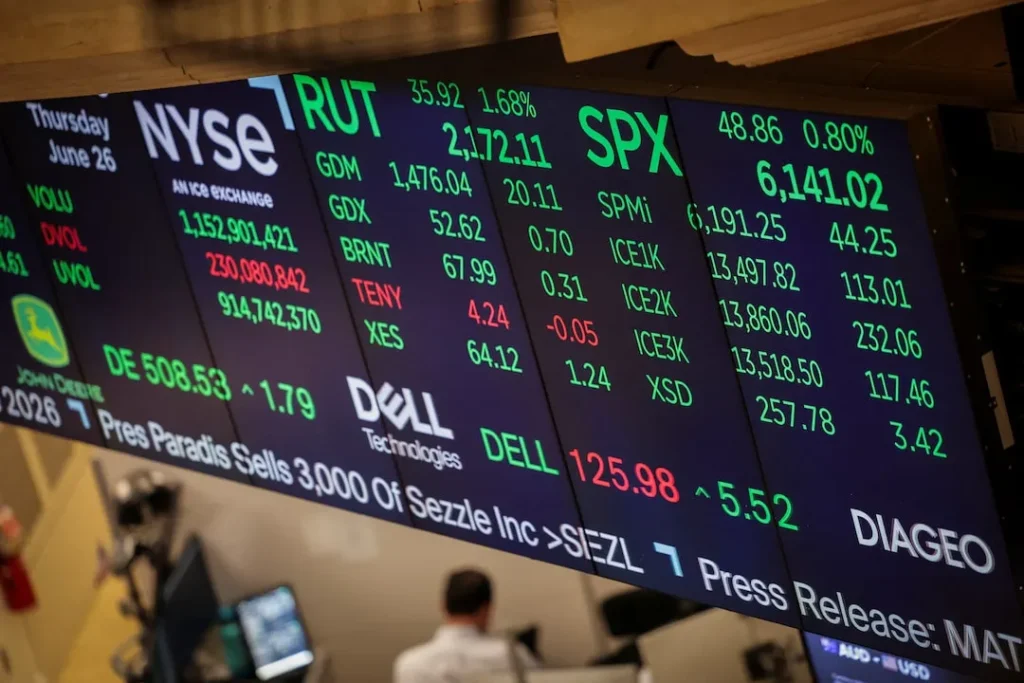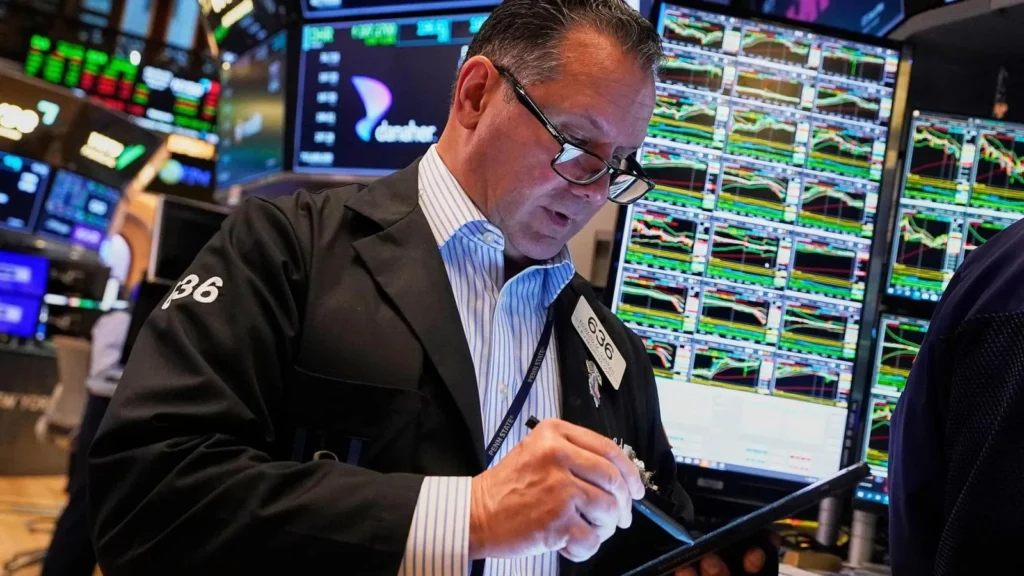Wall Street is on fire. In a striking display of investor confidence, U.S. markets have staged a powerful rally, propelled by two major forces: a breakthrough in international trade negotiations and growing expectations of a Federal Reserve interest rate cut. These dual catalysts have sent equities soaring, pushing major indices toward new highs and injecting fresh momentum into a market that had been teetering between uncertainty and recovery.
The rally is more than just numbers—it’s a reflection of shifting economic sentiment. For months, Wall Street grappled with volatility, fears of a recession, and geopolitical instability. Now, a sense of optimism is sweeping across trading floors, fueled by renewed global cooperation and monetary policy easing.
The Trade Deal That Reignited Confidence
The heart of the current rally lies in the announcement of a tentative trade agreement between the United States and a key global economic partner. After months—sometimes years—of uncertainty surrounding tariffs, supply chain disruptions, and retaliatory economic policies, both parties appear to have reached a framework for reducing trade tensions.
📈 Key Details of the Trade Deal:
- Tariff reductions on both sides
- Commitments to fair intellectual property practices
- Increased exports of agricultural and manufactured goods
- Mechanisms for ongoing dispute resolution
The mere suggestion of stability in the global trade environment has invigorated investor sentiment, especially in sectors most affected by prior tariffs—technology, industrials, and agriculture.

Market Reaction: Indices on the Rise
Wall Street’s reaction has been swift and forceful.
- 📊 The Dow Jones Industrial Average gained over 700 points in just two sessions.
- 🧾 The S&P 500 broke over psychological resistance levels and hit a new 52-week high.
- 🧮 The Nasdaq Composite, heavily weighted with tech stocks, jumped as trade-exposed companies surged.
Investor enthusiasm was also evident in trading volume, which spiked well above the monthly average, and in option market activity, suggesting bullish sentiment for weeks to come.
The Fed’s Dovish Pivot: Fuel for the Fire
In parallel to the trade breakthrough, the Federal Reserve signaled a potential rate cut at its upcoming meeting. Citing concerns over slowing job growth and global economic headwinds, Fed Chair Jerome Powell hinted that the central bank may adopt a more accommodative monetary stance to support continued expansion.
🏦 Why a Rate Cut Matters:
- Lower interest rates reduce borrowing costs for businesses and consumers
- Stimulates capital investment and housing demand
- Weakens the U.S. dollar, making exports more competitive
- Improves corporate profit margins, driving stock valuations higher
In short, Wall Street loves rate cuts. When paired with positive trade news, it’s a powerful cocktail of bullish momentum.
Sector Winners and Market Movers
Not all stocks are rallying equally. Specific sectors are benefiting more directly from the trade agreement and potential rate cuts:
🔧 Industrials and Manufacturing
Industrial behemoths like Caterpillar, Boeing, and General Electric witnessed double-digit weekly increases after struggling under retaliatory tariffs. The prospect of smoother global supply chains has rejuvenated confidence in the sector.
💻 Technology
Semiconductor stocks—often seen as barometers of trade health—have skyrocketed. Driven by the anticipation of increased demand and loosened constraints on cross-border chip sales, companies such as Nvidia, AMD, and Intel spearheaded the push.
🌽 Agriculture and Commodities
With trade terms favorable to U.S. exports, agribusiness stocks surged. Farmers and food producers expect a resurgence of demand from abroad, especially for cereals, pork, and soybeans.
🏦 Financials
Rate cuts may hurt bank margins in the short term, but the broader economic boost tends to lift financial stocks. The rally has included gains for JPMorgan Chase, Goldman Sachs, and regional lenders.

The Role of Global Markets
Wall Street’s gains aren’t happening in isolation. Global equity markets have also surged on the trade news and coordinated central bank dovishness.
- European markets rallied, led by German and French manufacturing stocks.
- Asian indices, including the Nikkei and Hang Seng, posted their best weeks of 2025.
- Emerging markets received inflows after months of outflows, thanks to reduced dollar pressure and improved trade prospects.
This synchronized global response strengthens the rally’s foundation, suggesting it’s more than just a short-term relief bounce.
Skepticism Remains: Is It Sustainable?
Despite the euphoria, some analysts are calling for caution. Key concerns include:
- The trade agreement is not yet finalized, and prior deals have fallen apart late in the process.
- A Fed rate cut could signal underlying economic weakness rather than strength.
- Inflation remains sticky, complicating the central bank’s options.
- The rally may be pricing in perfection, leaving markets vulnerable to any hiccups.
Still, even skeptics admit the tone has changed. There is a resilient optimism among investors that wasn’t present just a few months ago.
The Retail Investor Surge
Retail traders, many of whom re-entered the market during the pandemic boom, are once again driving volume and volatility. Platforms like Robinhood and Fidelity reported spikes in retail participation around major trade and Fed news.
- Trending stocks on Reddit and X (formerly Twitter) include semiconductors, defense contractors, and consumer goods exporters.
- Retail ETF flows have surged, especially into S&P 500 and Nasdaq-tracking funds.
- Sentiment surveys show small investors are increasingly bullish.
This resurgence of retail enthusiasm adds fuel to the fire, but also introduces the risk of overheated speculation.
Corporate Earnings Outlook
With Q3 earnings season on the horizon, analysts are upgrading projections based on trade relief and potential lower borrowing costs.
Sectors expecting the biggest upgrades:
- Consumer discretionary, fueled by cheaper credit and stable input prices
- Technology, with supply chain clarity and strong cloud demand
- Transportation, as freight volumes normalize amid better global trade routes
If companies beat these raised expectations, the market could push into all-time-high territory. But any disappointments could also trigger quick pullbacks.
The Political Angle
While market watchers focus on earnings and interest rates, the political backdrop is also shifting. A trade deal could strengthen the sitting administration’s position heading into the 2026 midterms. The Fed’s moves are likely to be scrutinized for political influence, even as Powell insists on independence.
Global geopolitical factors—elections in Europe, leadership transitions in Asia—could also influence the durability of these economic agreements.
Investors should prepare for volatility driven by headlines, especially if political tensions flare again.
Related Blog: Shell in Talks to Acquire BP in Historic Oil Mega-Merger
Conclusion: The Bulls Are Back—for Now
Wall Street’s rally, powered by trade relief and monetary easing, marks a major turning point in 2025’s economic narrative. After months of hesitation, investors are shifting their stance, rotating back into equities, and expressing renewed confidence in both corporate America and global cooperation.
But markets are dynamic, and optimism must now be matched by follow-through: actual deals signed, rates adjusted, and earnings delivered. If those fundamentals materialize, this could be the start of a sustained bull run. If not, the rally may fade as quickly as it arrived.
For now, though, Wall Street is celebrating—hope, after all, is once again priced in.
FAQs: Wall Street Rally on Trade Deal & Fed Optimism
Q1: What caused the recent Wall Street rally?
A: The rally was driven by a combination of a tentative international trade agreement and growing expectations of a Federal Reserve interest rate cut, both of which boosted investor confidence.
Q2: Which sectors benefited the most?
A: Industrial, technology, agriculture, and financial sectors saw the largest gains, especially companies directly impacted by tariffs or dependent on global trade.
Q3: What are the specifics of the trade deal?
A: While details are still emerging, the deal includes tariff reductions, IP protections, increased agricultural exports, and a dispute resolution mechanism.
Q4: Why is a Fed rate cut good for the stock market?
A: Rate cuts lower borrowing costs, stimulate economic activity, and generally improve corporate earnings—all of which tend to drive stock prices higher.




